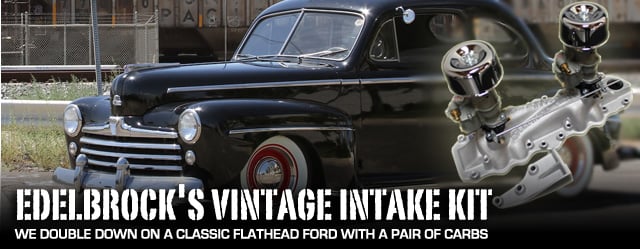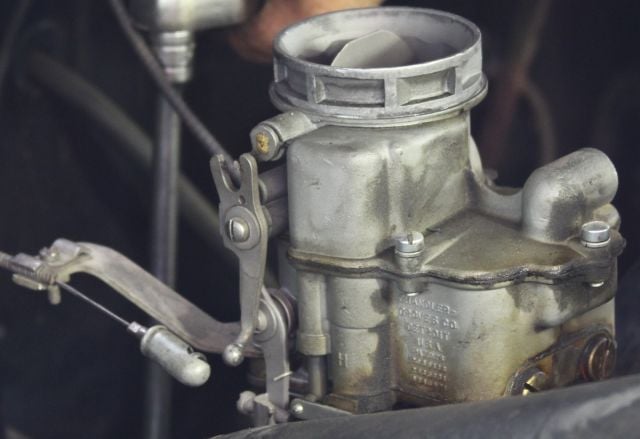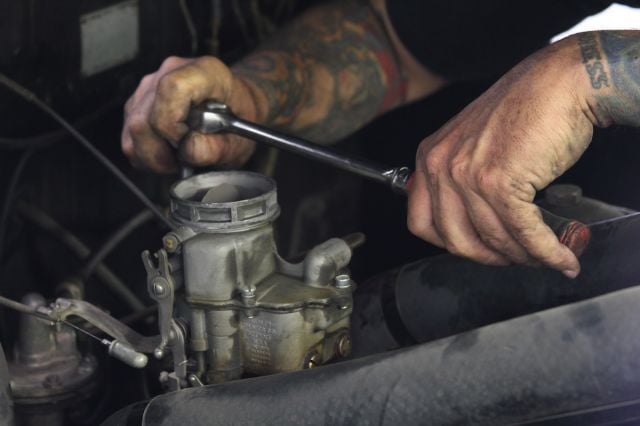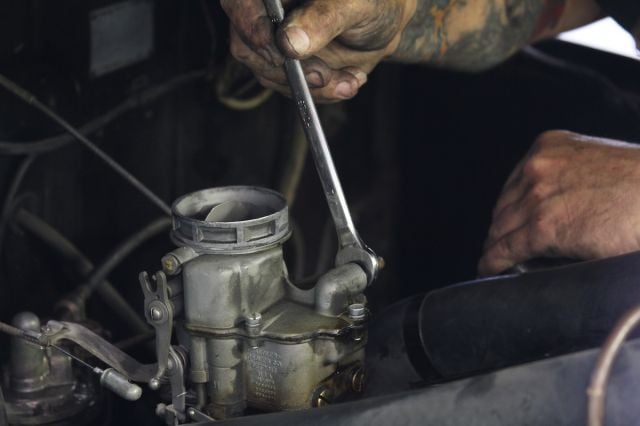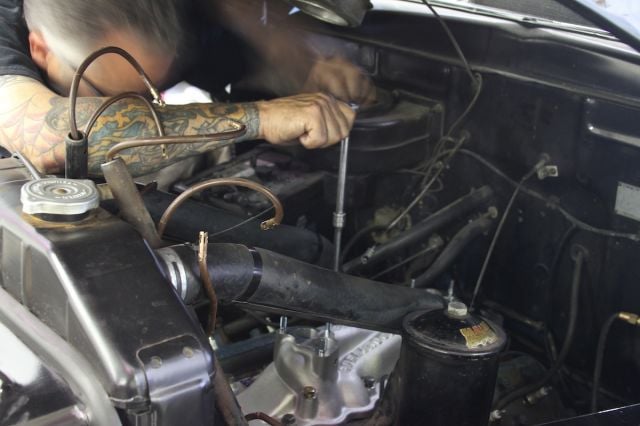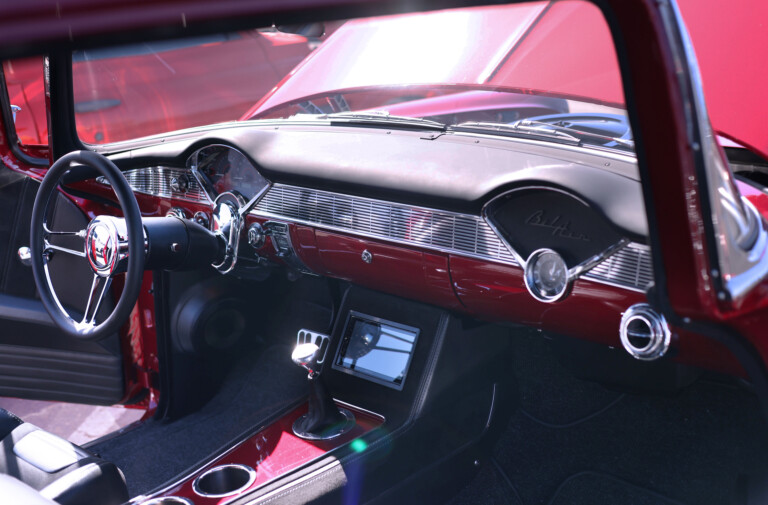Technology is an amazing thing; ever-changing and ever-expanding. However, there is much to be said for keeping a classic car with a classic look and feel. That’s exactly what we were after when we ran across this 1948 5-window Ford Coupe. The Flathead engine was terribly anemic with the single Holley 94 two-barrel stock carb designed with 60-octane fuel in mind back in the 1930s.
After WWII, hot rodders started adding a second, or even a third carburetor to these Flatheads, and they truly came to life. This is exactly what we wanted to do with the stock Ford Coupe, and keeping it retro, we went to the company that helped start the multi-carb set-ups on flatties… Edelbrock Performance.
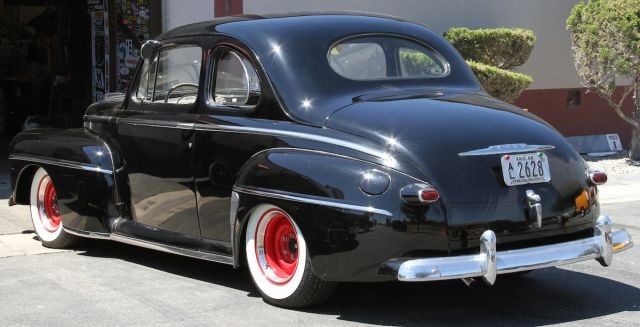
We found this 1948 5-window Ford Coupe in pretty stock condition. It was a perfect candidate for an improved intake and fuel delivery system to help the vintage flathead engine breathe.
The Overall Goal of the Project Build
According to car owner Bret Voelkel, founder of RideTech and guru of airride technologies, the Ford Coupe is all original, numbers matching, with no upgrades. Voelkel wanted to keep the car as original as possible with a few minor modifications. As you can tell from the photo above, they couldn’t keep the stock ride height for long, so she’s already been treated with a TCI front-clip and RideTech coilovers for a more respectable cruising height with added performance.
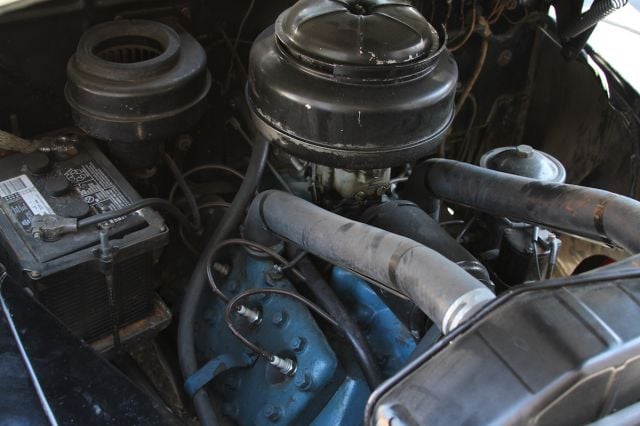
The Coupe's engine bay is typical of cars from that period, cluttered with a hood that doesn't open enough for easy access. The old style oil bath air cleaner and generator sitting on top of the engine makes any work under the hood a close quarters proposition.
Voelkel acquired the car from SoCal Speed’s Arizona shop, who had bought the classic from the original owner. The lineage of the car was concrete and every changed component was authenticated. Nothing more than routine maintenance and replacement of consumable parts had been done.
We want to keep the classic looks, even the original paint, but do a few upgrades to handling and reliability of the car. – James Crosby
Master hot rod mechanic James Crosby, who handles all of the Ridetech project car builds, explained the purpose of the project car, “we want to keep the classic looks, even the original paint, but do a few upgrades to handling and reliability of the car.” Outside of those enhancements, Voelkel desires to keep the rod on the vintage side of things.
Here Comes Edelbrock
Enter Edelbrock Performance, armed with the understanding that classic hot rods can benefit from a few upgrades so that they can handle the rigors of daily driving and still deliver consistent, reliable street performance when needed.
Edelbrock knew that one of the best upgrades that you can perform on these old flathead engines is by improving the intake system, helping the engine to breathe better. Edelbrock began as a company by developing and improving Flathead Ford performance with custom intakes in the early days.
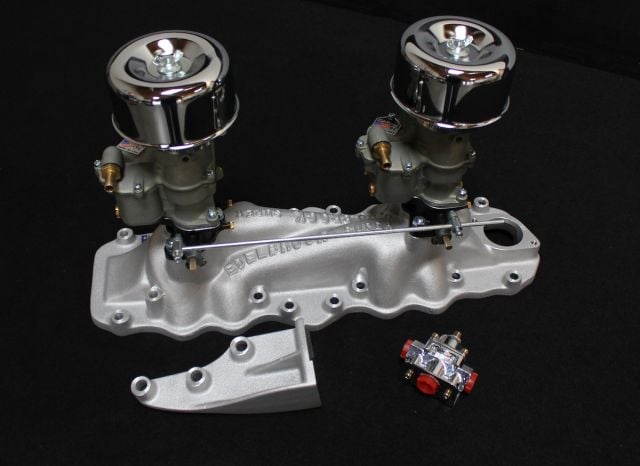
Edelbrock's vintage manifold and carburetor kit include an Edelbrock dual or triple deuce intake manifold with two or three of Edelbrock's 94 carburetors, and straight throttle linkage for dual or triple carb setup on Flathead Fords. A generator re-location bracket is required for multiple carb set-ups and is also included in the kit.
The Issue
The car came equipped with a Holley 94 Carburetor, as did many of the Fords from 1938 to 1957. The 94s were originally developed by the Chandler Groves Company under contract to Henry Ford, who was looking to replace the Stromberg 97 carburetors Ford was currently using. Chandler Groves developed a completely new carburetor for Ford’s new 24-stud Flathead engine, in exchange for the patent rights, they were awarded a one-year contract to supply all the carbs for the 1938 year Ford production run.
At the end of the year contract, Ford took the carb design, blueprints and all, and found a company that was willing to offer a better price on the manufactured carburetors. Holley became the sole manufacturer of the 94s until they were phased out in 1957.
In 1941, Vic Edelbrock Sr designed his own manifold for Flathead Fords, nicknamed “The Slingshot,” which used two Stromberg 97 carburetors. Edelbrock drove his test car, equipped with the new dual Stromberg 97 carbs and the slingshot manifold, to a national speed record in the flying quarter mile.
There has been some debate over the years on which design was better, the 94s or the 97s. For performance, no one has been able to prove that there is a distinct advantage in one design over the other… until now.
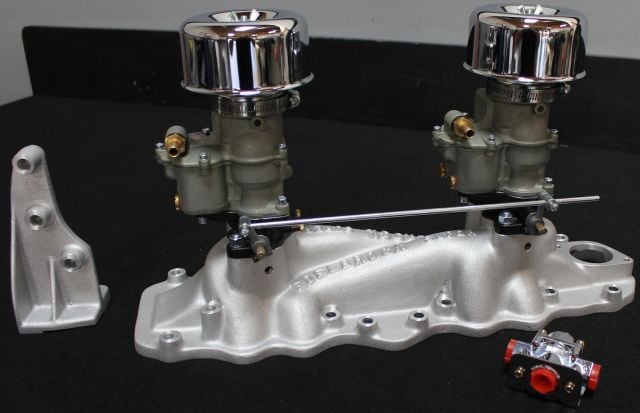
Edelbrock's vintage manifold and carb kit comes with the core components to double up the carbs on your Flathead Ford.
The Solution
According to Edelbrock’s Technical Sales Coordinator Smitty Smith, “Our vintage manifold and carb kits are a great solution for adding dual or triple deuce power to street rods. All the core components are put together in one box for a hassle-free bolt on installation.”
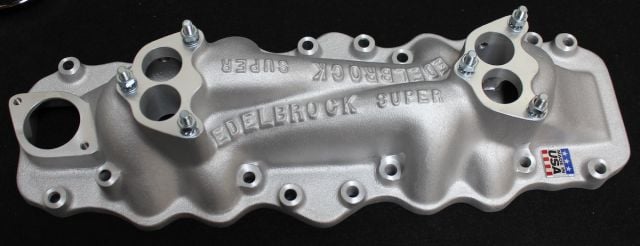
Edelbrock's Super Dual intake manifold features a dual plane design, eliminated heat crossover and carb location over port openings.
The kits include an Edelbrock dual or triple deuce intake manifold with two or three of the Edelbrock 94 carburetors, straight throttle linkage (part #1032 for dual or 1034 for triple carb setup) on Flathead Fords.
For the Chevy fans, Edelbrock offers a progressive throttle linkage (part #1033) that was originally designed by Vic Edelbrock Sr. in the late 1950s for small block Chevy applications.
“The progressive triple carburetor throttle linkage was engineered as a bolt on solution for multiple carb set-ups,” said Smith, adding, “it’s designed to operate on single or two carburetors in part throttle, then synchronizes all three carbs to open fully at wide open throttle. The progressive nature provides a smoother throttle operation and gets rid of flat spots in the throttle.”
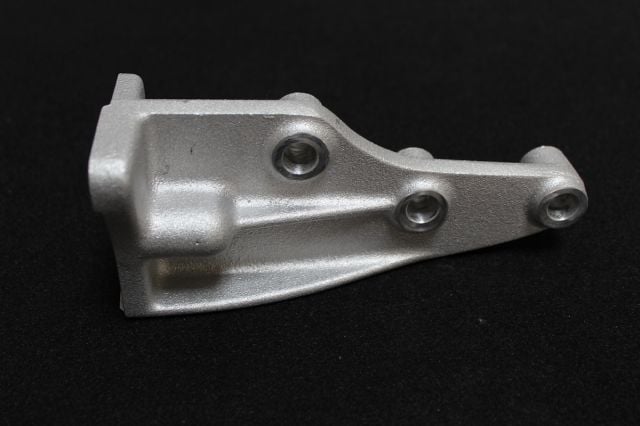
The Super Dual intake manifold comes with Edelbrock's generator relocation bracket for carburetor clearance at the front of the manifold.
According to Smith, the Edelbrock 94 carbs are manufactured with an extended length throttle shaft to simplify adding the throttle linkage.
Smith recommended adding Edelbrock’s Mini Fuel Distribution Block kit (part #1281) to make the fuel supply setup to the carbs simplistic. “It includes everything you need to connect the primary fuel line to the carbs, like neoprene hose, fittings and the distribution block,” he assured us.
About the Edelbrock Two-Barrel 94 Carburetors
Edelbrock’s 94 Two-Barrel carburetors offer several advantages over other two barrel style carburetors in the placement of the fuel inlet, fuel float and the design of the fuel discharge.
When combined with their dual or triple manifold, complete with straight throttle linkage and mini fuel block, the 94s become a very consistent street performer for the flathead engine fans.
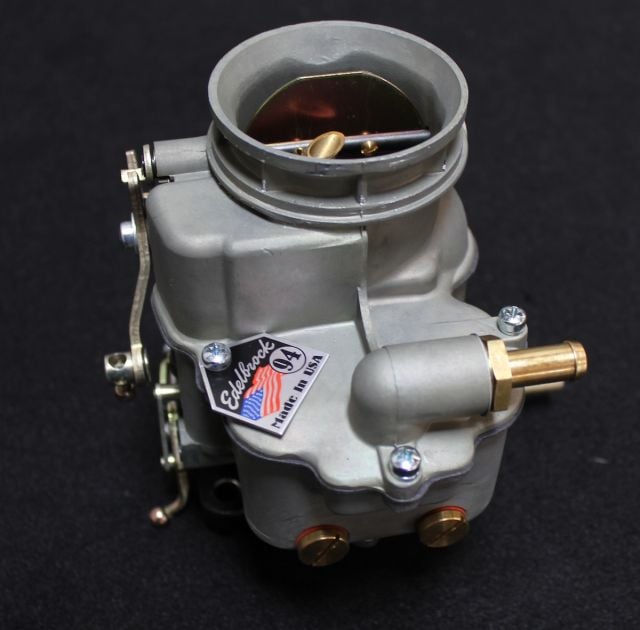 Features of Edelbrock’s 94 Two-Barrel Carburetors
Features of Edelbrock’s 94 Two-Barrel Carburetors
- Machined and assembled by Edelbrock in the U.S.A.
- Features a 3-bolt flange and cast aluminum base that fits any standard 3-bolt intake manifold.
- Includes calibration instructions for Flathead and small cubic inch V8 engines
- Works extremely well with matched components like Edelbrock’s intake manifold, cylinder heads, linkage, fuel blocks and Classic series accessories.
Edelbrock 94 Factory Specifications
- Main Jet: .053″
- Power Valve: 5.5″
- Float Level: 1-11/32″
- Fuel Pressure: 3.0-3.5 psi (regulator required)
- Finish: Zinc-Dichromate
The core advantages of Edelbrock’s 94 Two-Barrel Carburetors:
- Edelbrock’s two-barrel 94 carburetors are designed with the fuel inlet on top of the float bowl where the Stromberg 97 design places the fuel inlet on the side of the bowl. In addition to letting gravity do some of the fuel delivery, the 94’s fuel inlet location uncomplicates the fuel line routing in some engine bays.
- The Edelbrock 94s also use a center-hung float rather than the side hung design of the 97 style carbs. Center-hung floats are less likely to cause flooding or fuel starvation when hard cornering.
- The 94s are designed with a spray bar for discharging fuel into the main system for better atomization of the fuel, whereas the 97 style carbs use emulsion tubes.
Our Installation
We opted to install Edelbrock’s Dual Carb kit with the Super Dual intake manifold (part # 2011) for 1938-1948 Flathead Fords. The engine bay of the 5-window coupe was pretty tight, so trying to shoehorn the triple carb kit on top of the flattie may have posed a problem.
The Edelbrock vintage dual carb kit also comes with a generator relocation bracket that moves the generator over to the passenger side of the engine block giving the front carburetor enough room to be installed on the manifold. Using the generator re-location bracket requires three 4 3/4-inch head studs which can be purchased at ARP under part #4-75S.
Edelbrock also recommends using Fel-Pro intake manifold gasket #MS2853, which can be ordered at any parts store. Edelbrock’s installation sheet also specified using Gasgacinch sealant to the gasket surface and allowing it to air dry before installing the manifold bolts in the typical criss-cross fashion, tightening them down to 20-25 ft/lbs.
Removing the old stock system begins with removing the generator bracket, all lines and cables to the intake system and removing the intake mounting bolts.
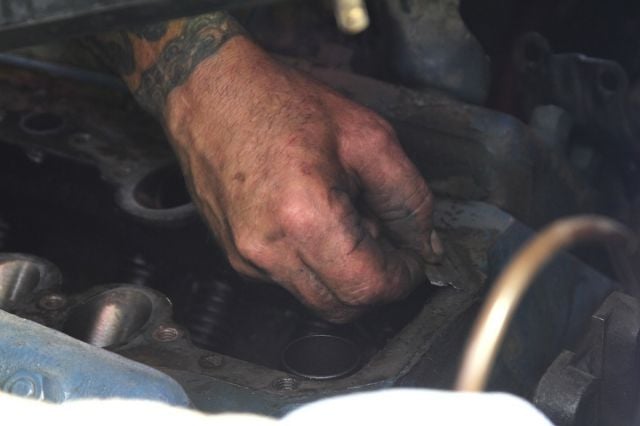
Make a clean mating surface by removing all of the old gasket material with a gasket scraper or razor blade. We recommend using shop rags or equivalent in the lifter valley to catch any debris.
We also found that the stock drive belt would not work once the generator relocation bracket was installed. Fortunately Gates Corporation makes a belt that is perfect for the new set up. The Gates Hi-Power II (part #B54) is the perfect drive belt fit for the relocated generator.
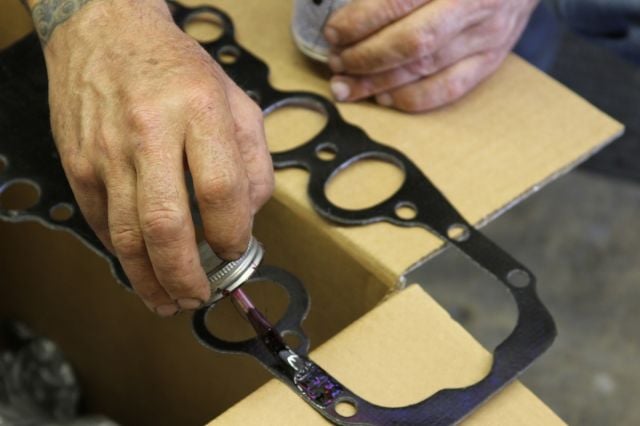
Applying Gasgacinch to the Fel-Pro intake gasket will help hold it in place and prevent vacuum leaks.
Installing the Carbs
We found that there is a few things that are handy to have on hand before installing the new dual 94s on the manifold. Any throttle brackets and bolts you might need to attach the accelerator cable to the throttle linkage, throttle return springs and fuel filter.
It only makes sense to replace the fuel filter when you are attaching the new fuel lines and new carburetors to the manifold. Edelbrock’s part #8135 is a good replacement filter and you know that it will fit the Edelbrock supplied fuel line that comes with the mini fuel distribution block. Besides, if you don’t use a new filter when you install the new carbs, it voids the carburetor’s warranty.
Carefully lowering the intake manifold into place, the mounting bolts were tightened and the carburetors installed on the manifold studs.
Edelbrock’s throttle return spring kit (part #8005) is handy to have for carb and throttle linkage installation. Re-using the old throttle return spring may sound like a good deal but you need to remember that springs loose tension over time, and may even break after several years of service.
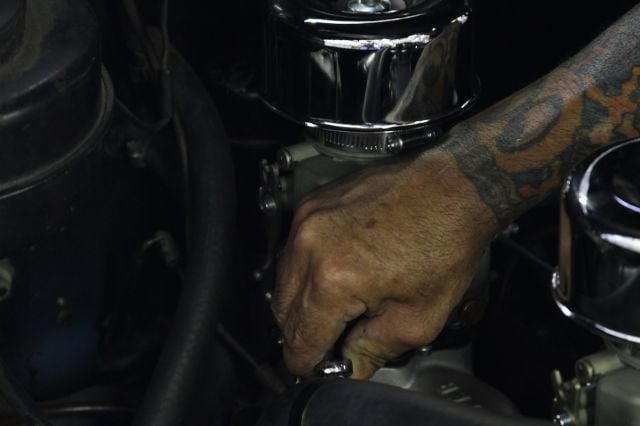
Use care when tightening the carburetor mount bolts. Slightly tighter than finger tight is all that is needed.
It’s also a good idea to check the fuel pump for proper operation before re-installing it on the manifold.
Edelbrock warns against using any type of adhesive on the new carburetor gaskets. Simply install the supplied mounting studs into the manifold, place the new carburetor gasket over the studs and carefully place the carburetor over the gasket.
Carefully hand tighten the mounting nuts and washers. Use care to avoid overtightening the mounting nuts and breaking the carburetor base. A snug hand tight fit is all that is required on the mounting nuts.
We added the suggested mini fuel distribution block (part #1281) and the fuel pressure regulator (part #1789) to route fuel to our dual carb set up under the low pressure requires. The regulator is rated to work between 1 and 4 PSI, which is perfect for the Edelbrock 94s delivery to the small bored flathead. According to the Edelbrock engineers, excessive fuel pressure will bring flooding and over rich conditions. There is no reason to use more than 3 PSI of fuel pressure with the Edelbrock 94 dual set up.
Following the instructions that came with the straight throttle linkage, the initial carb set up and calibration was a snap. Checking for any interference in the throttle plates or cables will prevent any binding of the throttle. There’s nothing quite as exciting as having a throttle hang open on you at wide open throttle because of a binding issue.
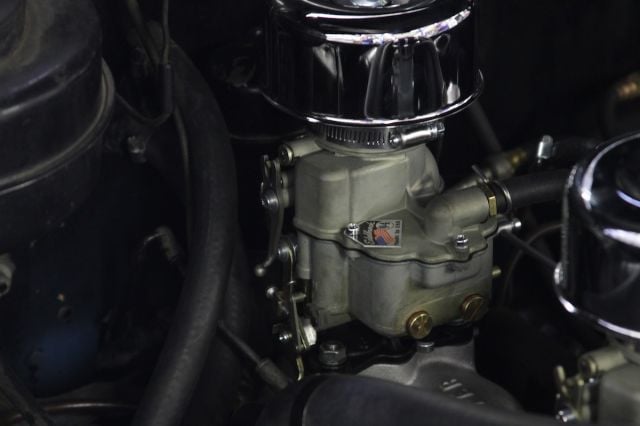
Once the carburetors are installed, all vacuum lines, fuel lines, throttle linkage and cables can be attached.
Connecting the fuel line and any vacuum lines and choke cables are the final steps to getting the engine ready to fire. If a choke cable is not used, the choke blade must be fixed in the open position. The easiest way to lock the choke in open position is to remove the choke lever at the pivot bolt and install a star washer below the flat washer.
We also highly recommend a last visual inspection prior to hitting the starter and turning the engine over.
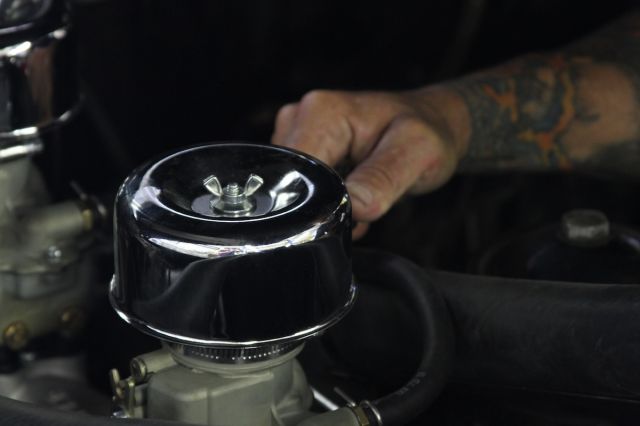
The last step in the installation, after the engine has been warmed up and the carburetors set for optimal running conditions, attach the air cleaners and recheck the engine idle.
Fire It Up
Once the engine has been started, carefully check for any vacuum leaks, signs of fuel leaks or other irregularities while the engine gets to normal operating temperature.
The idle speed and mixture can be adjusted once the engine reaches normal operating temperature. Edelbrock recommends using their Uni-Syn tool (part #4025) to balance the air flow at idle for multiple carb set-ups.
The Uni-Syn tool is much more accurate than the old method of using a rubber hose held to the ear listening to the hiss of air being sucked into the carburetor and adjusting airflow based on the sound of the air.
When the idle speed and mixture are set to optimum, the air cleaner can be re-installed. We opted to install Edelbrock’s 94 Round Air Cleaner, which is specifically designed to work with the 2 5/8-inch diameter two-barrel carburetor.
The round air cleaner provides plenty of surface for air entering the carb and it cleans up the engine bay by removing the bulky old stock air cleaner. With the new air cleaners installed and the generator re-located to the passenger side of the block, the top of the flathead engine is much more accessible and less cluttered.
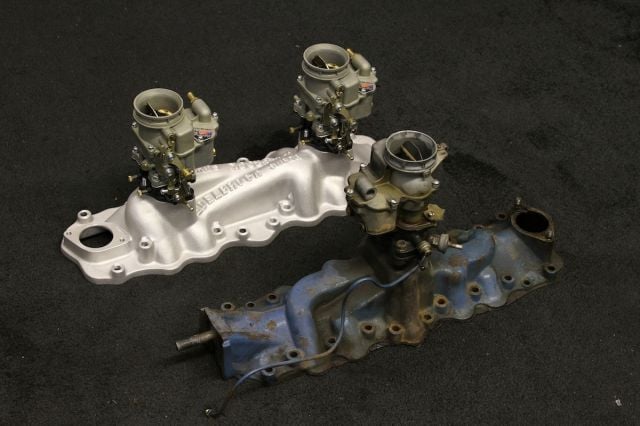
Edelbrock's vintage manifold and carburetor kits add a classic look and dependable street performance. The differences between the anemic stock intake and the Edelbrock intake system are easily noticeable.
Last Thoughts
Multiple carb set-ups on hot rods is nothing new but Edelbrock’s vintage manifold and carb kits are. What sets them apart from piecing together various components is the testing that the Edelbrock engineers have done with all the components on one platform. This ensures that the individual components will work well together.
Not only will the components work together for better overall performance, Edelbrock engineers designed the multiple carb manifolds to work with original components like stock Ford distributors.
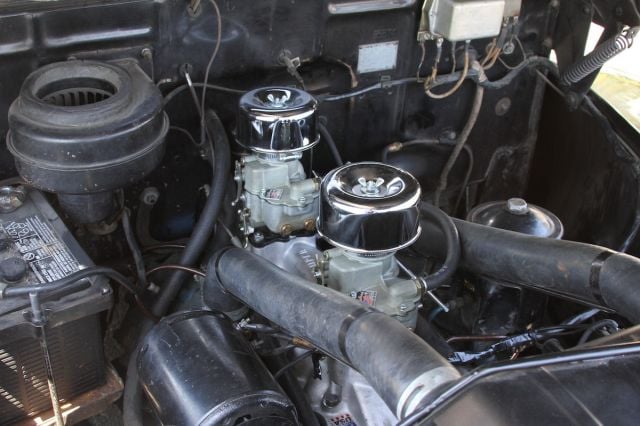
With the generator relocated to the passenger side of the block, and the old oil bath air cleaner removed, there is more room on the top of the engine - even with the addition of another carburetor.
Hot rodders switching to multiple carb set-ups in the past have experienced ignition timing problems because of the lower vacuum signal caused by splitting the airflow to the engine. Stock Holley/Ford 94 carburetors supplied the vacuum signal for the distributor’s advance unit from the venturi of the carburetor which resulted in a lower vacuum signal.
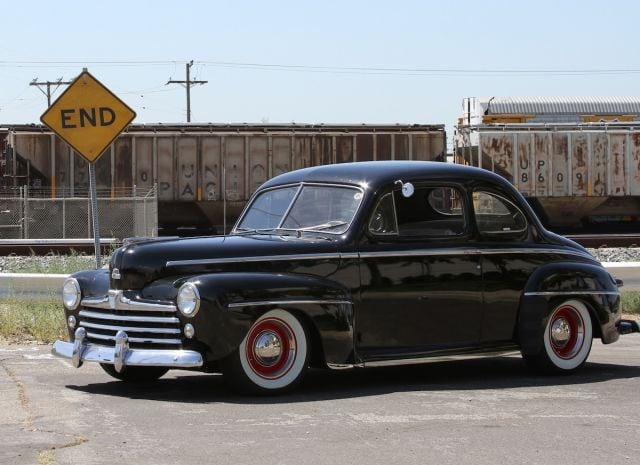
We couldn't resist doing a little bit of street testing once the new intake system was installed. During the 'testing' we found a nice place to photograph our classic car.
Edelbrock’s manifolds are equipped with a port that can be used to supply the vacuum signal directly from the manifold to the advance unit, eliminating the need to change the stock distributor to an aftermarket one. Adding reliable performance while keeping the stock look and feel of a classic is the hallmark of Edelbrock’s vintage manifold and carb kits. Everything you need in one box that is “bolt on” easy to install and even easier to maintain.



